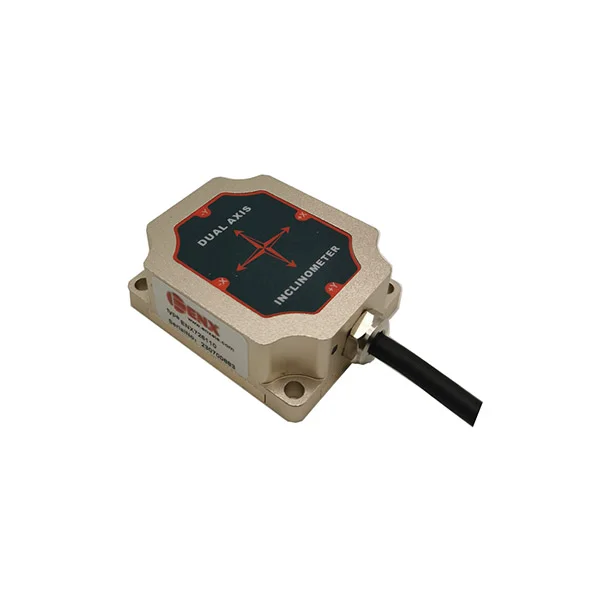High precision inclinometer sensors are fundamental components in a wide range of industries, providing accurate angular measurements relative to the gravity vector. These sensors are used in civil engineering, geotechnical monitoring, robotics, aerospace, and industrial automation for applications that demand high levels of accuracy and reliability. Understanding their working principle involves a multidisciplinary approach that spans mechanical engineering, materials science, electronics, and signal processing. In this blog post, as a professional high quality industrial sensor manufacturing factory, ENX Enxiao will share the working principle of high precision inclinometer sensor for sale.
1. Definition and Purpose
An inclinometer, also known as a tilt sensor or clinometer, is a device that measures the angle of tilt, elevation, or depression of an object with respect to gravity. High precision inclinometers are capable of measuring small angular deviations—often down to arc seconds or micro-radians—with extremely low noise and high repeatability. These sensors are distinguished by their sensitivity, resolution, linearity, and stability over time and temperature variations.
2. Basic Operating Principle
The core working principle of an inclinometer sensor is the detection of angular displacement due to gravity. The direction of gravity provides a constant reference vector, and any tilt in the sensor' s orientation results in a measurable change in the projection of gravitational force along its sensitive axis.
High precision inclinometers typically operate on one of the following physical principles:
* Electrolytic conduction
* Capacitive displacement
* MEMS (Micro-Electro-Mechanical Systems) acceleration
* Servo force-balance mechanisms
* Pendulum-based optical or magnetic sensing
Each method has advantages and trade-offs in terms of precision, temperature stability, response time, and environmental tolerance.
3. MEMS-Based High Precision Inclinometers
One of the most common technologies used in modern high precision inclinometers is MEMS. These sensors use microscopic mechanical elements fabricated on silicon wafers that behave as capacitive accelerometers.
How MEMS Accelerometers Work in Inclinometers
* A MEMS accelerometer contains a proof mass suspended by microstructures within the chip.
* When the device tilts, gravity causes a deflection in the position of the proof mass.
* This displacement changes the capacitance between fixed electrodes and the proof mass.
* An analog or digital circuit converts this capacitive change into a voltage or current signal proportional to tilt.
Because gravity is a constant vector, only the component of gravity projected onto the sensitive axis of the sensor varies with tilt. For small angles, this projection is linearly related to the sine of the tilt angle:
a=g⋅sin(θ)
For angles less than ±10°, the sine function approximates a linear relationship, simplifying signal conditioning.
4. Servo-Based Force Balance Inclinometers
For applications requiring even higher precision, such as geotechnical and structural health monitoring, servo-based inclinometers are preferred. These devices employ a force-balance mechanism that actively maintains the position of a pendulum or seismic mass at a null point.
Working Principle of Force Balance Sensors
* A pendulum is mounted within a feedback loop.
* When the sensor tilts, the pendulum tends to move due to gravity.
* A position sensor detects this movement and activates a feedback coil or electrostatic actuator.
* A compensating force is applied to bring the pendulum back to its original position.
* The current required to generate this force is proportional to the angle of tilt.
This closed-loop control provides exceptional linearity, low hysteresis, and resistance to external vibrations, making it suitable for high-precision and low-frequency tilt measurements.
5. Signal Conditioning and Output Processing
The raw output of an inclinometer—whether voltage, current, capacitance, or digital signal—must undergo conditioning to be useful in precision measurement systems.
Key Signal Conditioning Steps
* Amplification: Low-level analog signals are amplified to increase signal-to-noise ratio.
* Filtering: Low-pass filters remove high-frequency noise, which is crucial for applications in static or quasi-static conditions.
* Linearization: Mathematical correction of the non-linear response, especially at higher tilt angles.
* Temperature Compensation: Corrections based on embedded temperature sensors to account for thermal drift.
* Analog-to-Digital Conversion (ADC): For digital inclinometers, high-resolution ADCs (up to 24-bit) convert the conditioned analog signal.
Many high-end inclinometers integrate microcontrollers or digital signal processors (DSPs) to perform real-time corrections, data logging, and communication with external systems via protocols like RS-485, CAN, or Modbus.

6. Calibration and Accuracy Assurance
Calibration is crucial in achieving high accuracy in inclinometer measurements. This involves aligning the sensor output with known angular references and compensating for errors such as offset, scale factor deviation, cross-axis sensitivity, and non-linearity.
Calibration Techniques
* Two-Position Calibration: Rotating the sensor 180° about its sensitive axis to determine offset and gain.
* Three-Axis Gimbal Calibration: Using precise rotary tables to characterize sensor behavior over a full range of motion.
* Environmental Calibration: Exposing the sensor to different temperatures and mechanical stresses to model drift behaviors.
Calibration data is stored in the sensor' s non-volatile memory, and applied in real-time during operation.
7. Error Sources and Compensation Methods
No inclinometer is perfect. Several factors contribute to measurement error:
* Bias Instability: Long-term drift of the zero-tilt output.
* Noise: Random variations due to electronic or thermal fluctuations.
* Cross-Axis Sensitivity: Tilt in one axis influencing the measurement in another.
* Temperature Drift: Changes in material properties or electronics affecting output.
Manufacturers employ techniques like temperature-compensated components, digital filtering, and advanced materials to mitigate these effects. Users may also apply real-time error modeling in software to further refine data.
8. Performance Metrics
The performance of a high precision inclinometer is defined by several key metrics:
|
Parameter |
Description |
|
Resolution |
Smallest detectable change in tilt, often < 0.001° |
|
Accuracy |
Maximum deviation from the true tilt angle, often ±0.01° or better |
|
Repeatability |
Ability to return to the same output after repeated tilting |
|
Linearity |
Deviation of the output from a straight line over full scale |
|
Bandwidth |
Frequency range over which the sensor accurately responds |
|
Zero Offset |
Output when sensor is level; critical for differential measurements |
9. Applications of High Precision Inclinometers
The combination of high accuracy and reliability makes these sensors indispensable in critical applications:
* Civil and Structural Engineering: Monitoring bridge deflections, building settlement, dam movement.
* Geotechnical Monitoring: Detecting slope stability and land deformation.
* Aerospace and Defense: Satellite alignment, UAV stabilization.
* Industrial Automation: Robotic joint positioning, heavy machinery leveling.
* Medical Devices: Patient positioning in diagnostics and rehabilitation.
10. Conclusion
High precision inclinometer sensors are marvels of modern engineering that convert subtle angular changes into precise electronic signals. Their working principle, grounded in the physics of gravity and enhanced through sophisticated electromechanical designs and signal processing, allows them to achieve remarkable levels of accuracy and stability. As applications demand ever tighter tolerances and smarter diagnostics, inclinometer technology continues to evolve—integrating AI, wireless communication, and edge computing to redefine what' s possible in tilt measurement.
www.enxsensors.com
ENX Enxiao


